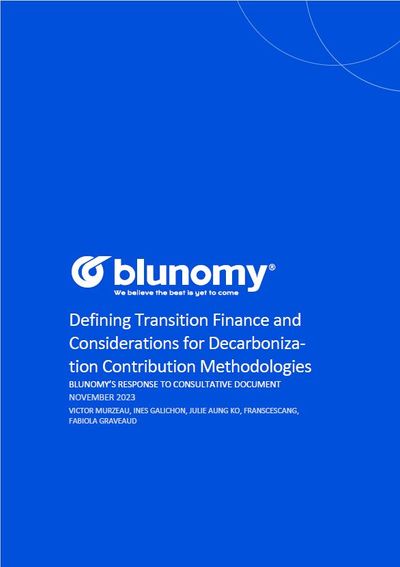Defining Transition Finance and Considerations for Decarbonization Contribution Methodologies

Leveraging our expertise in climate scenarios, climate transition and extensive track record with financial institutions on climate alignment and strategy, Blunomy participated in the public consultation launched by the Glasgow Financial Alliance for Net Zero (GFANZ) on “Transition Finance Strategies and Measuring the Impact on Emissions”. Following this consultative period, the GFANZ published a technical supplement to its Net-zero Transition Plans report (“Scaling Transition Finance and Real-economy Decarbonization”) and shared the results of the consultation at COP28.
We welcome GFANZ's work to define “transition” more precisely, which could provide a valuable "compass" for investors to navigate the necessary transformation of their portfolio.
Our participation in this public consultation reflects our commitment to harmonising climate alignment methodologies and tools for financial institutions. We also took this opportunity to provide our insights on addressing the complexity of transition in portfolio alignment.
- The methodology to assess the level of alignment, in essence, combines activities, measures and scenarios to provide portfolio analysis at the asset, activity or company level.
- We advocate for a clear and consistent definition of "transition" across asset, business and corporate levels to guide varied investment and financing strategies.
- While some concepts need to be understood at the activity or asset level (climate solutions, phase-out management), others relate more to a company's transition maturity and performance (aligned, aligning). When assessing the transition level of an activity, asset or company, it is essential to account for sector- and asset-specific characteristics to align closely with real-world decarbonisation pathways.
- Developing a "transition" scale to precisely analyse companies based on ambition, readiness and transition performance is crucial for directing capital to firms with credible transition strategies and guiding tailored engagement strategies with portfolio companies. Semi-quantitative methods like a “maturity scale” can address data availability and quality challenges while offering actionable insights for financial institutions along their portfolio trajectory.